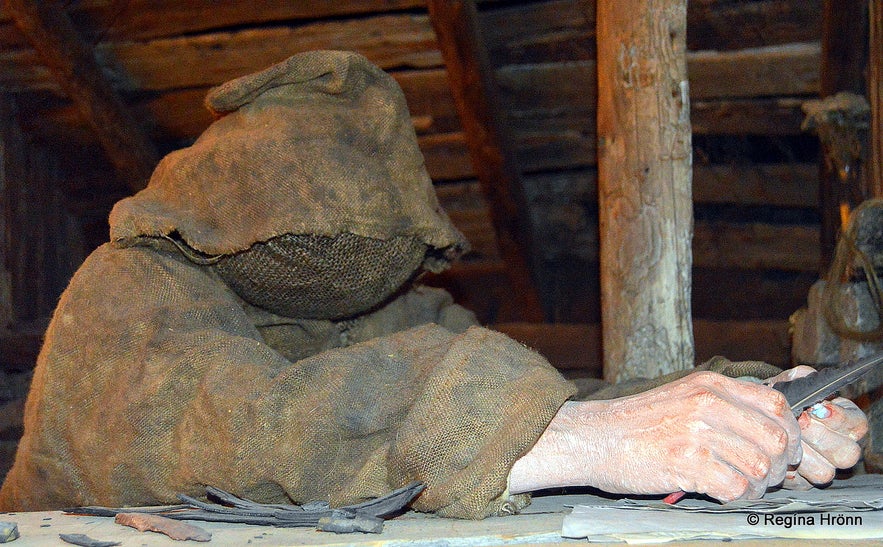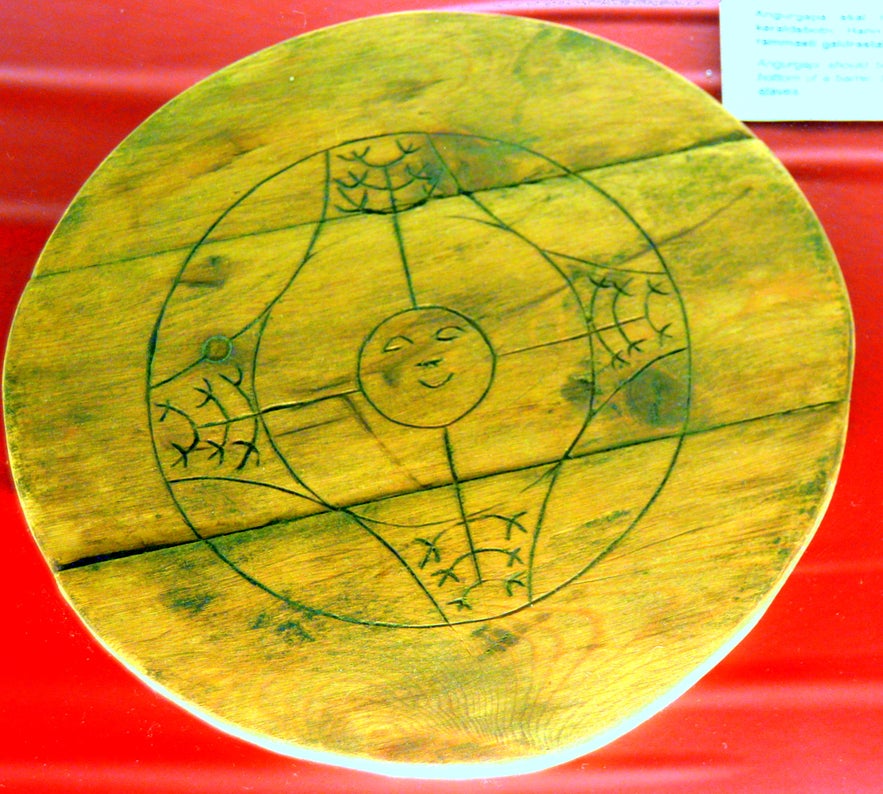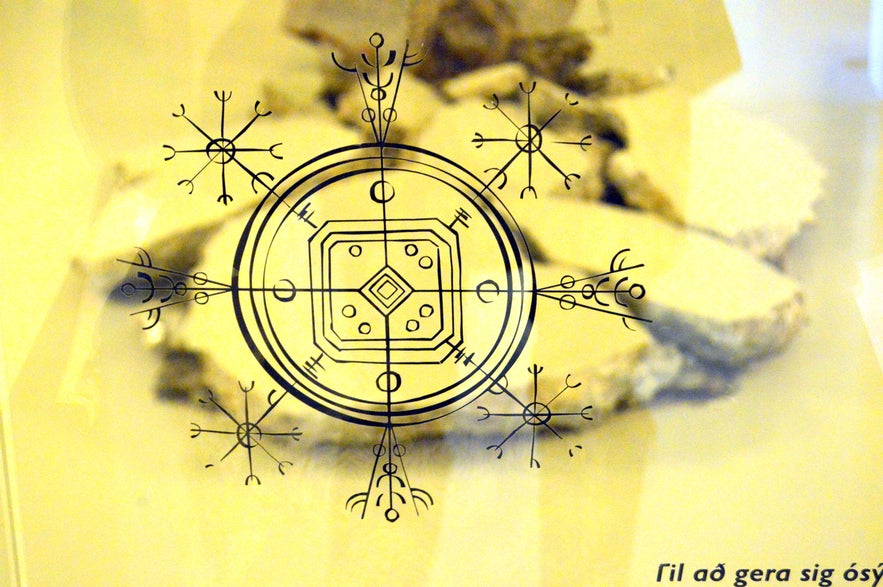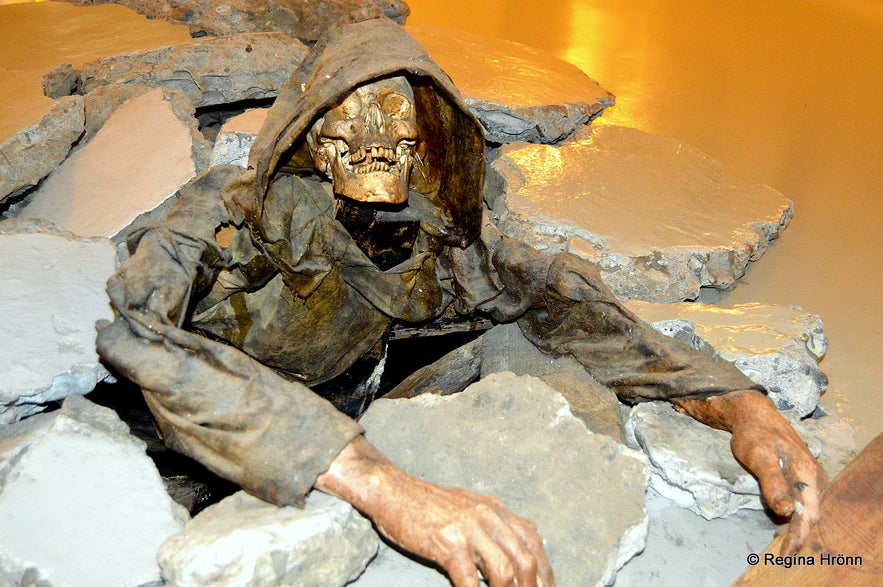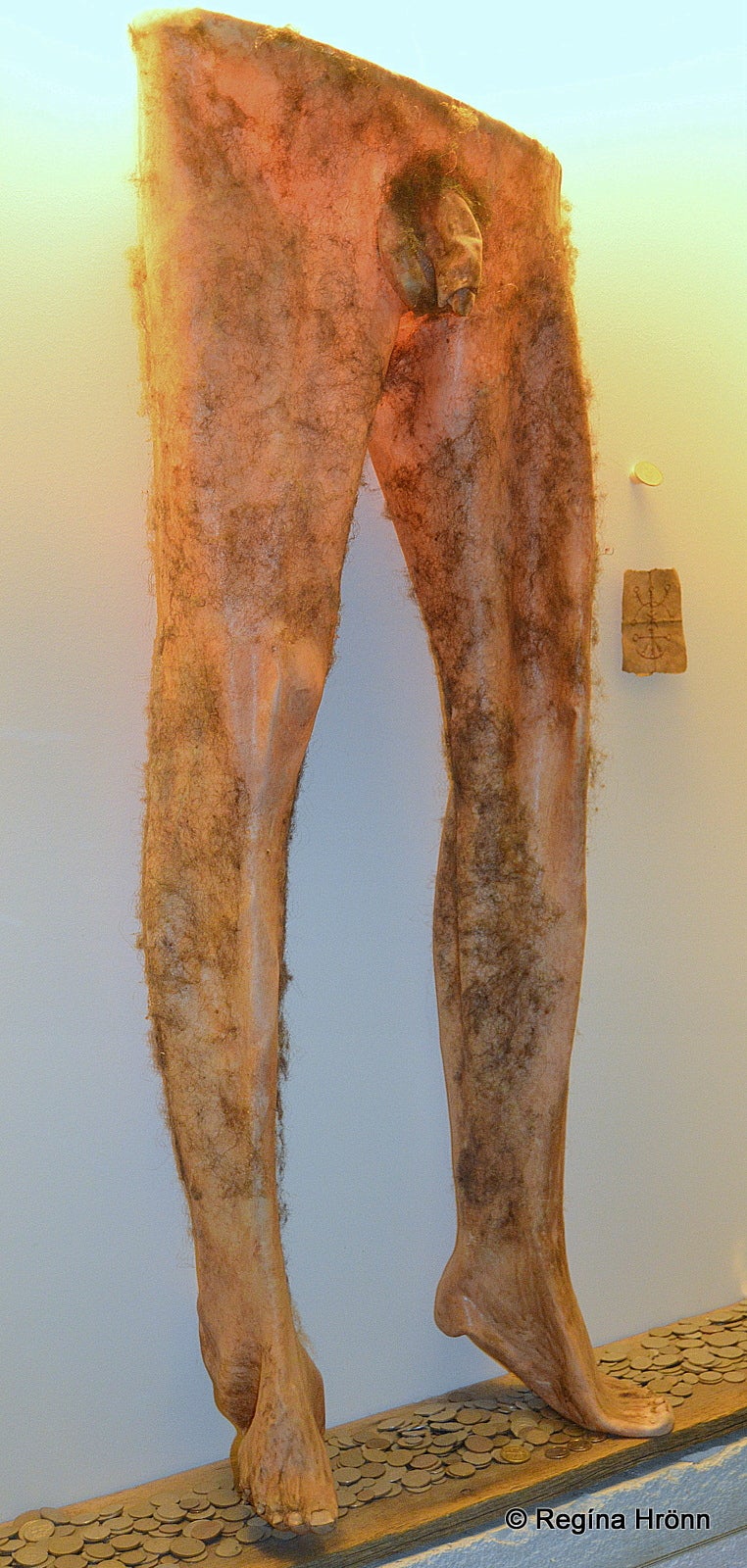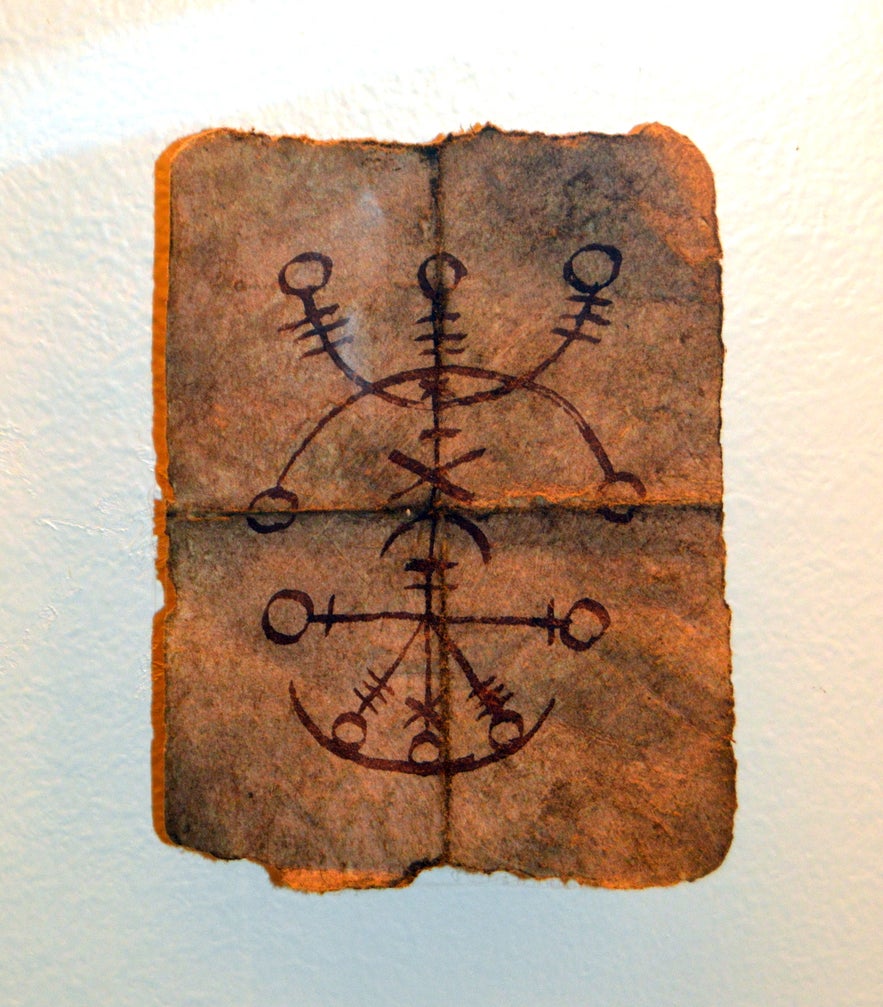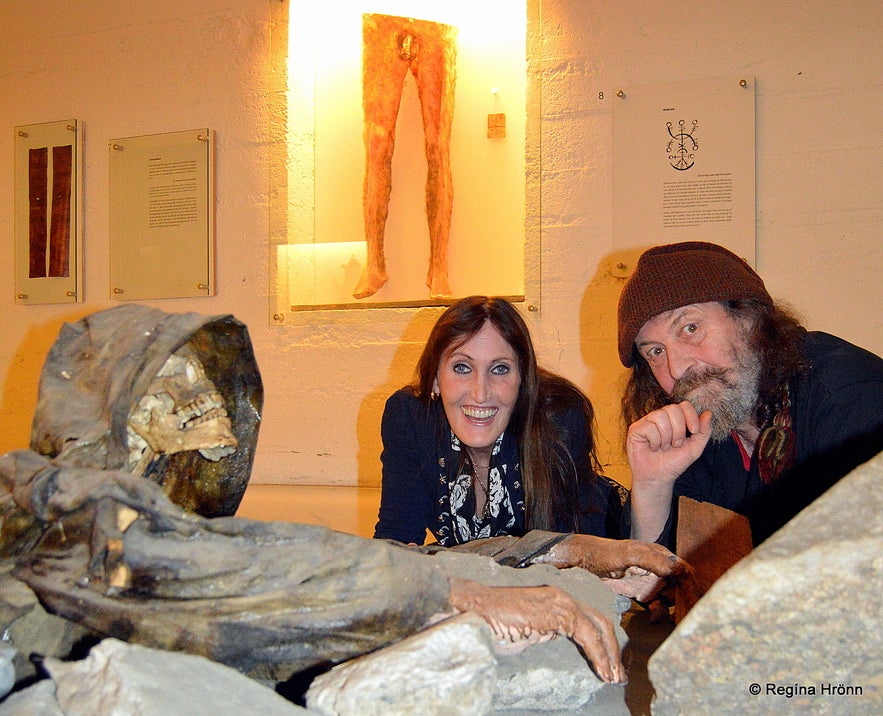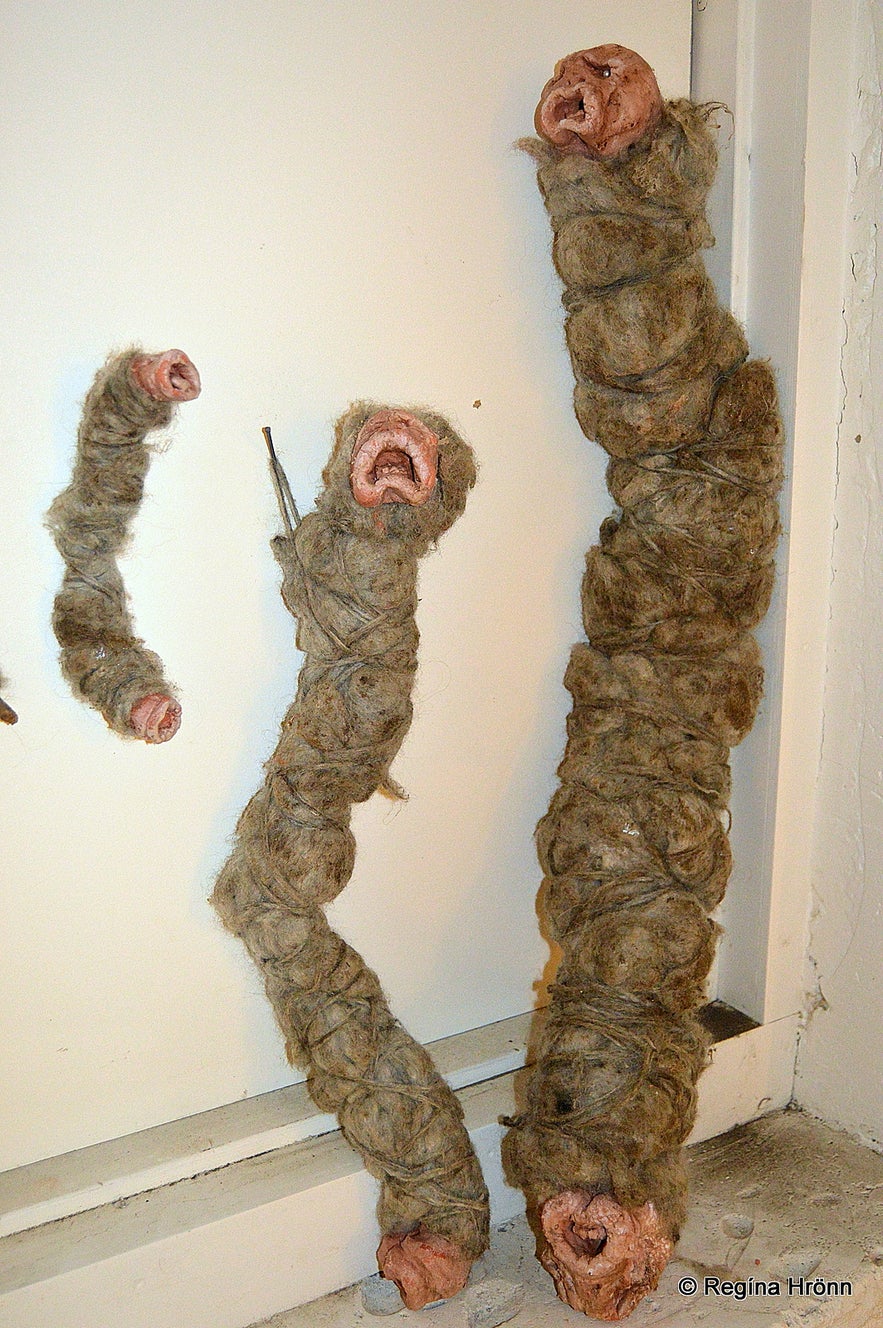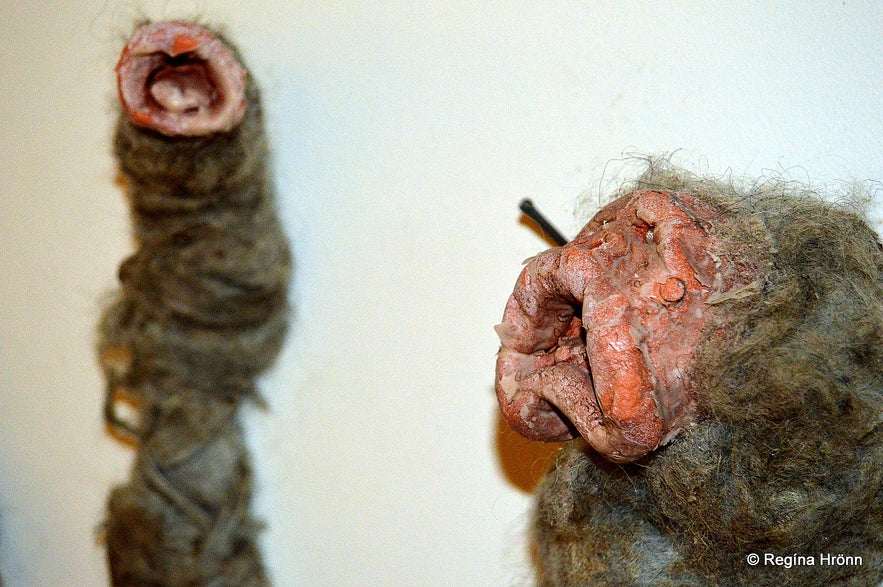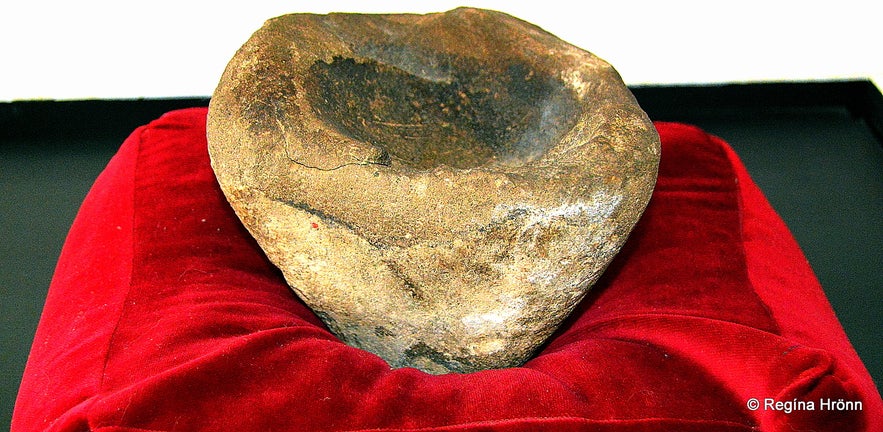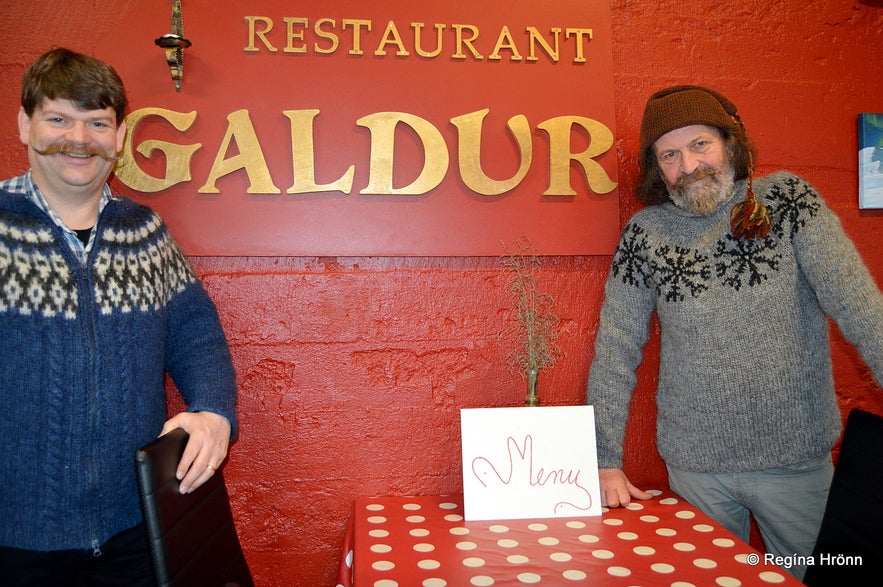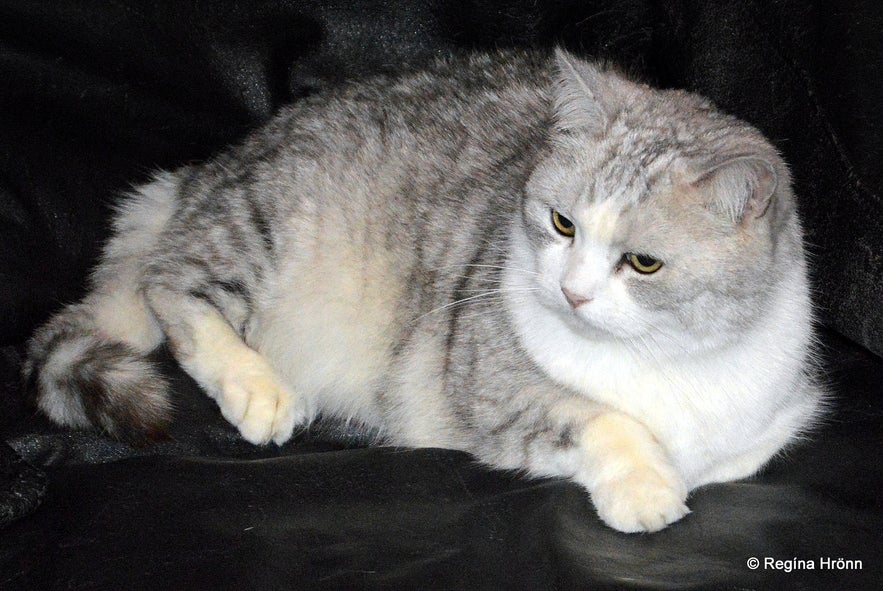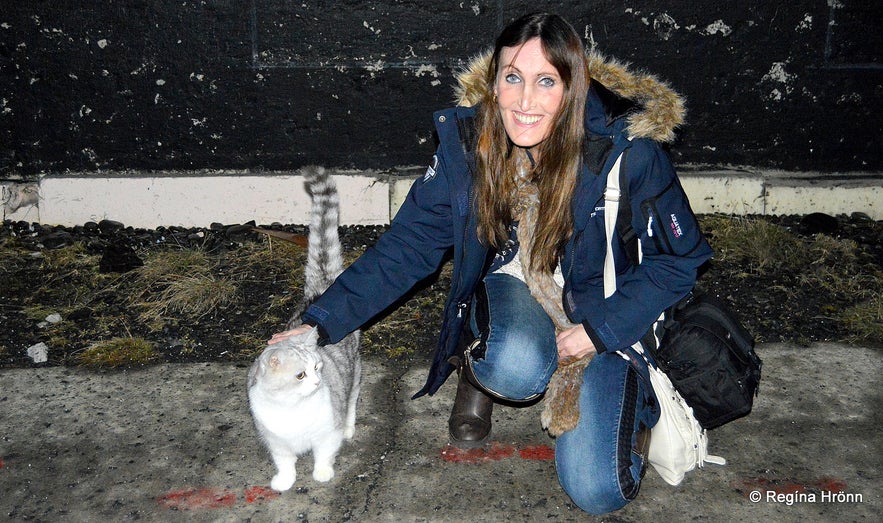
The Museum of Icelandic Witchcraft and Sorcery at Hólmavík in the Westfjords Region of Iceland
A very popular museum is to be found in Hólmavík village, on the east side of the Westfjords Region of Iceland, which is a must-visit while in this area. This museum is called the Museum of Sorcery and Witchcraft or "Galdrasafnið" in Icelandic.
The museum is on two floors and depicts the history of sorcery, which was seemingly powerful in this area of Iceland called Strandir.
Top photo: A creepy guy at the Sorcery museum
Angurgapi magical stave
The museum is not for the faint-hearted and even though I have visited this museum several times I still get the chills being in there - surrounded by zombies, milk-sucking demons, and magical staves.
Amongst the many magical staves is the one in my photo above "Angurgapi" - which is one of the most powerful magical staves in Iceland. It looks so innocent though.
I almost feel uncomfortable having it here in my travel-blog!
Hulinhjálmur - the magical stave for making oneself invisible!
At the museum, you can learn all about Icelandic witchcraft - even how to make yourself invisible! And you will even "see" an invisible boy!
It was in the year 1652 that the first man was burned as a sorcerer, up in North Iceland. His name was Jón Rögnvaldsson and he was charged with raising a ghost (zombie) to cause harm to his enemy.
At Trékyllisvík three men were burnt at the stake for sorcery in 1654. A witch hunt followed and this period of time in Iceland, from 1654-1690, has been called "Brennuöldin" or the Fire century. Another 16 men and 1 woman were burnt at the stake, the last one in 1683.
I am happy that I was not alive in these dark ages of Iceland.
The zombie crawling out from the floor!
You can see the zombie crawling out from the floor of the museum. It is really scary looking
The curator, Sigurður Atlason, sorcerer, is with me in some of the photos. He is a lovely man and quite a colourful character. He was even willing to lie down on the floor with me by the zombie to get a good photo for my travel-blog.
Sadly Sigurður died suddenly in November 2018 :( He will be missed.
With the late Sigurður Atlason on the floor talking to the zombie
It was a strange scene, here I was lying on the floor with a sorcerer next to a zombie - while a magician was taking our photo! Life is sometimes very strange ;)
The Necropants
The necropants at the Museum of Icelandic Witchcraft and Sorcery
Stave for Necropants
Now, this is by far the most infamous piece at the museum - the horrible necropants, which date back to the 17th century. I read about them in "Þjóðsögur Jóns Árnasonar" - the Collection of Folklore of Jón Árnason, but I go this English translation from the homepage of the museum:
"If you want to make your own necropants (literally; nábrók) you have to get permission from a living man to use his skin after his death. After he has been buried you must dig up his body and flay the skin of the corpse in one piece from the waist down. As soon as you step into the pants they will stick to your own skin.
A coin must be stolen from a poor widow and placed in the scrotum along with the magical sign, "nábrókarstafur", written on a piece of paper.
The magical stave for the necropants
Consequently, the coin will draw money into the scrotum so it will never be empty, as long as the original coin is not removed. To ensure salvation the owner has to convince someone else to overtake the pants and step into each leg as soon as he gets out of it. The necropants will thus keep the money-gathering nature for generations". - Nice, eh!
The necropants on display at the museum are a replica made from the measurements of a local man at Strandir - the curator of the museum told me that he didn't know if these were his private parts as well or if they are just made up ;)
With the late Sigurður Atlason at the museum
The news about the necropants have travelled all over the world and Stephen Fry talked about them in his show QI and claimed that this is how the Icelandic economic system works ;) The show caused havoc and the museum saw many more visitors after the show aired - most of them were looking for the necropants!
There are of course many interesting things on display at this museum, but these necropants have become the most infamous ones.
Tilberi - the milk-sucking demon
Tilberi - the milk-sucking demon
There were horrible-looking creatures at the museum which caught my attention. They are called "tilberi" and are milk-sucking demons! Women were supposed to create tilberi to amass butter. They would send the tilberi, which had mouths on both ends, to suckle on the cows of other farmers until it was filled with milk. It would then return to their "mother" and vomit into the churn for making butter - and their vomit was almost pure butter, albeit a little lumpy!!
I found step-by-step instructions on how to create this demon in "Þjóðsögur Jóns Árnasonar" - the Collection of Folklore of Jón Árnason:
"Snakkur or tilberi are made by women in the way that they steal a rib from a corpse at the cemetery. On Whitsunday, they steal a piece of copper, which they break from a church clock. Then they pluck wool from between the shoulders of a newly sheared sheep, which belongs to a widow.
Tilberi - the milk-sucking demons
They then enwrap the wool around the human rib and the piece of copper and keep it between their breasts. Next time they go to communion they spit the sanctified wine out and into the wool with the rib and the copper and the tilberi is thus created.
The tilberi gets its nutrition from suckling on the women. The women are easily recognized by their limp and the sanguine teat-like wart on the inside of their thigh, on which the tilberi suckles. To get rid of a tilberi: let them pick up all the lamb droppings on three highland pastures and bring to the women - then the tilberi explodes! (This creature cannot stand the holy number 3).
A really strange creature, indeed!
From a distance, the tilberi is long and inflated, convex on both ends, and moves very quickly by putting one end at a time on the ground while twisting and turning. The butter of tilberi can be recognized by making the sign of the cross in the butter with a finger and if it explodes into small pieces, then it is the butter of a tilberi.
Hence the custom that when women knead the butter they make the sign of the cross in the butter with a finger".
(Translated into English from "Þjóðsögur Jóns Árnasonar" - the Collection of Folklore of Jón Árnason).
The Ritualistic Stone from Viking Times
The Ritualistic Stone from Viking Times
Resting on a crimson velvet cushion is the only ritualistic stone from Viking times ever found in Iceland. It is believed to have been used in connection with sacrifices to the Viking Gods - and remnants of animal blood can still be found in the bowl.
This bowl was found in "Goðdalur" - the Valley of Deity in Bjarnarfjörður valley in the Westfjords Region and according to folklore there was a heathen temple in this valley.
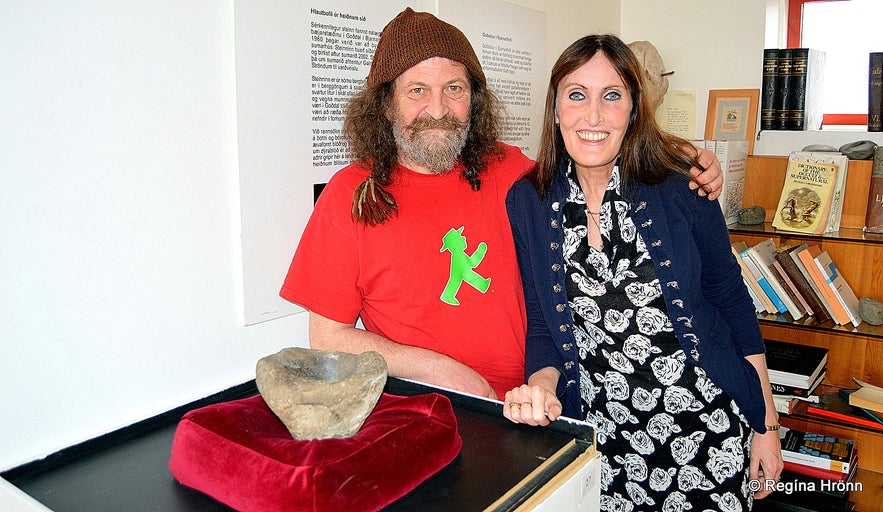
With Sigurður by the ritual stone
There is also a burial mound in this remote valley containing the remains of the Viking Goði. It is said that both these places, where the heathen temple and the burial mound are located, are jinxed and should never be disturbed.
Forensic tests have been carried out to ascertain that the ancient blood is authentic.
Restaurant Galdur
The magician and the sorcerer
My husband and I were staying for 3 days in Hólmavík as he was taking part in the Children's Cultural Festival of the Westfjords.
We stayed at Steinhúsið, which is next to the Museum of Icelandic Sorcery and Witchcraft, and decided on having dinner at the Galdur restaurant. This restaurant is located at the museum and is run by the curator of the museum, the "sorcerer" Sigurður Atlason. You can see him with my magician husband, Jón, in the photo above.
Sigurður is wearing a woolen sweater with magical staves, but these sweaters are for sale at the museum. Plus many other things with magical staves, like the glass below. Both the sweater and the glass have the Ægishjálmur magical stave - the Helm of awe (or helm of terror); to give one courage and to protect one against abuse of power and dictatorship.
The plates and glasses have magical staves
The first night we were the only ones dining at the restaurant and had a good chat with the curator. My husband had the beef, which he said was excellent. I have food allergies so I rarely eat at restaurants. The second night the restaurant was absolutely packed, which was even lovelier as there was such a good atmosphere in there :)
My husband had the lamb, which he praised; and this man loves his food! The service was fast and friendly and we felt totally relaxed and at home.
Hippo the Cat
Hippó the Cat at the Museum of Icelandic Witchcraft and Sorcery
Hippó (Hippopotamus) the Cat is the cat of the curator of the Museum of Icelandic Sorcery and Witchcraft, Sigurður Atlason. This cat has got many fans around the world.
Hippó is partly Persian, with a beautiful thick white and grey fur. It is obviously very well kept by its owner, Sigurður. People started writing about Hippó in blogs, on Facebook, and on Twitter and guests started asking about this lovely cat. I had read about it on the news and when I posted photos on Facebook of the Museum of Icelandic Sorcery and Witchcraft one of my relatives asked me if I had met Hippó.
Hippó the Cat at the museum
She is a personal friend of Sigurður and owns cats, which are friends with Hippó. I had forgotten to ask about Hippó, so off I went to the museum again and asked to see the cat. It was sleeping at home, but Sigurður told me that he would bring it to the museum in the evening. So finally I met this famous cat when we dined at the museum on our second night in Hólmavík. Other guests at the restaurant at the museum enjoyed the company of Hippó as well and were petting it and taking photos of it.
Hippó, the museum cat, lent its name to a charity and was the protector of funding for Kattholt, which is our cat shelter. Hippo thus raised ISK 65,000 for homeless cats and helped Kattholt from being closed down. A postcard with a photo of Hippó was made and sold and the profits went to Kattholt. People from all over the world took photos of Hippó and sent them to the museum and, one of these photos was chosen for the postcard.
Petting Hippo outside the museum
The Museum of Icelandic Sorcery and Witchcraft is open every day from 11:00-14:00 and 17:00-20:00. The same opening hours are valid for the Restaurant Galdur. Look up the website of Strandagaldur to see the admittance fee.
If you want to join a really cool guided walking tour in Reykjavík then I recommend the Icelandic Mythical Walk | Trolls, Elves & Hidden People, where you get to know about the necropants and how to wake up a zombie, amongst many other interesting stories from Icelandic folklore.
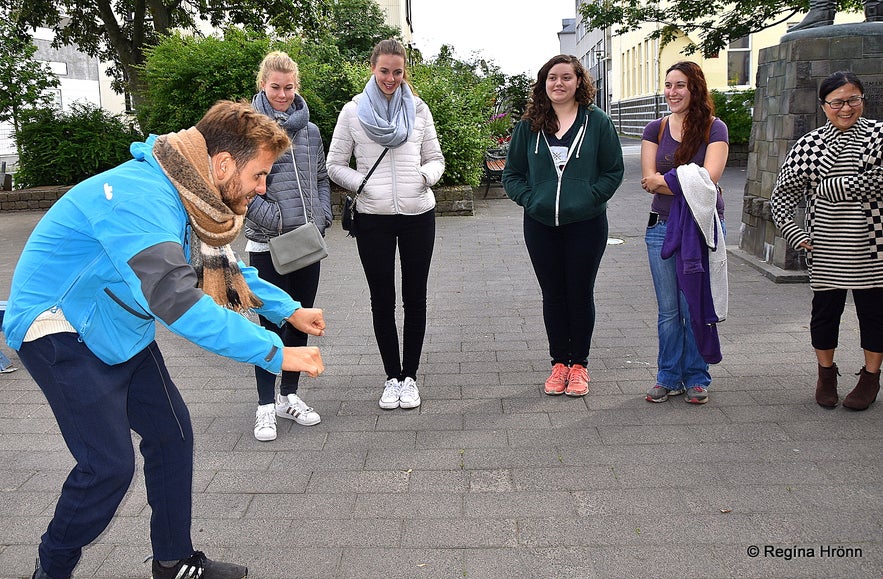
Our Reykjavík guide showing us how to wake up a zombie
See also my travel-blogs:
Hólmavík in the Westfjords Region of Iceland - the Sorcery Town!
The Mystical Sorcerer's Cottage in Bjarnarfjörður in the Westfjords Region - Kotbýli kuklarans
The remote Strandir in the Westfjords Region of Iceland - Stillness & Sorcery
Hólmavík is located 230 km away from Reykjavík. You can rent a car in Reykjavík and drive up there in a day.
Have a lovely time at the Sorcery museum and at Strandir :)
其他有意思的博客
冰岛最浪漫的角落
对于很多人,遥远的冰岛有着世界尽头的神秘,有着区别于巴黎、马尔代夫、自成一体的浪漫。没有埃菲尔铁塔和蒂凡尼,没有热带沙滩,而是在冰川、火山、苔藓地的背景下蜜月旅拍、婚拍,甚至举办一场冰岛婚礼。来冰岛旅行,多是要跨千山万水、飞跃大洋大陆,很有一点“万水千山陪你走过”的史诗感。难怪很多人说,光是冰岛二字,就足够浪漫了。 冰岛虽然不大,但是地貌极其丰富,不同的自然景观自然有不同的气质。这一篇,就挑阅读更多从极光观测到摄影-到底该不该来冰岛看极光
很多朋友都想来冰岛看极光,但是冰岛到底适不适合看极光呢?几月、什么季节能看到极光?是不是一定要参加北极光旅行团?如何能拍摄出美丽的极光照片呢?在冰岛住了好几年了,从刚开始逢极光必出门,到如今家里阳台就能看极光,我对在冰岛看极光的了解和经验,也算得上大半个专家了,且听我娓娓道来吧。 到底该不该来冰岛看极光呢?最坦诚的答案是,不要只为了看极光而看极光。 极光原理 太阳活动→太阅读更多
迷失冰岛的米湖游览推荐|不只有温泉的地热宝藏区
我在冬夏秋均到访过米湖,看过米湖的不同面。一直以来,米湖到底值不值得去是很多游客争论的问题。有些人觉得这里是来冰岛旅行的必去目的地,有些人则说米湖“太丑了”,连照片都不想多拍几张。那米湖到底值不值得来呢?到底怎么玩呢? 米湖的风景 北部的米湖,因地理位置相距首都雷克雅未克略远,很多来冰岛的短途游客选择放弃,其实米湖应该是和黄金圈、南岸沿线至冰湖齐名的冰岛景色,这里冷热相融,可谓最冰岛,尤其阅读更多

将冰岛最大的旅行平台下载到您的手机中,一站式管理您的整个行程
使用手机摄像头扫描此二维码,然后点击显示的链接,将冰岛最大的旅行平台添加到您的手机中。输入您的电话号码或电子邮件地址,以接收包含下载链接的短信或电子邮件。

